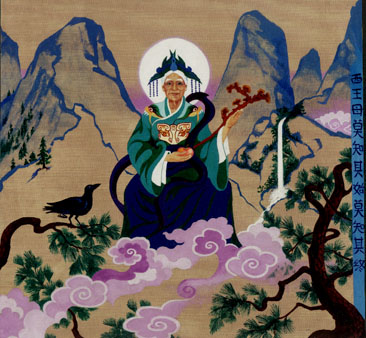Electra
Active Member
Xi Wangmu, the shamanic great goddess of China
Max Dashu

Max Dashu

One of the oldest deities of China is Xi Wangmu (Hsi Wang Mu). She lives in the Kunlun mountains in the far west, at the margin of heaven and earth. In a garden hidden by high clouds, her peaches of immortality grow on a colossal Tree, only ripening once every 3000 years. The Tree is a cosmic axis that connects heaven and earth, a ladder traveled by spirits and shamans.
Xi Wang Mu controls the cosmic forces: time and space and the pivotal Great Dipper constellation. With her powers of creation and destruction, she ordains life and death, disease and healing, and determines the life spans of all living beings. The energies of new growth surround her like a cloud. She is attended by hosts of spirits and transcendentals. She presides over the dead and afterlife, and confers divine realization and immortality on spiritual seekers.
The name of the goddess is usually translated as Queen Mother of the West. Mu means “mother,” and Wang, “sovereign.” But Wangmu was not a title for royal women. It means “grandmother,” as in the Book of Changes, Hexagram 35: “One receives these boon blessings from one’s wangmu.” The classical glossary Erya says that wangmu was used as an honorific for female ancestors. [Goldin, 83] The ancient commentator Guo Pu explained that “one adds wang in order to honor them.” Another gloss says it was used to mean “great.” Paul Goldin points out that the Chinese commonly used wang “to denote spirits of any kind,” and numinous power. He makes a convincing case for translating the name of the goddess as “Spirit-Mother of the West.” [Goldin, 83-85]
The oldest reference to Xi Wangmu is an oracle bone inscription from the Shang dynasty, thirty-three centuries ago: “If we make offering to the Eastern Mother and Western Mother there will be approval.” The inscription pairs her with another female, not the male partner invented for her by medieval writers—and this pairing with a goddess of the East persisted in folk religion. Suzanne Cahill, an authority on Xi Wangmu, places her as one of several ancient “mu divinities” of the directions, “mothers” who are connected to the sun and moon, or to their paths through the heavens. She notes that the widespread tiger images on Shang bronze offerings vessels may have been associated with the western mu deity, an association of tiger and west that goes back to the neolithic. [Cahill, 12-13]
After the oracle bones, no written records of the goddess appear for a thousand years, until the “Inner Chapters” of the Zhuang Zi, circa 300 BCE. This early Taoist text casts her as a woman who attained the Tao [Feng, 125]:
Xi Wang Mu attained it and took her seat on Shao Guang mountain.
No one knows her beginning and no one knows her end.
find this and more here
